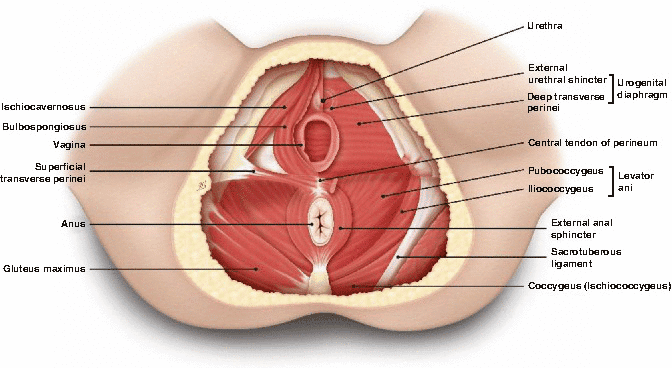By Dr. Megan Jones, PhD, CSCS
The Female Pelvic Floor
The female pelvic floor, often a topic shrouded in mystery, is a complex and crucial part of a woman’s anatomy. Comprising a network of muscles, ligaments, and connective tissues, the pelvic floor resembles a hammock that spans from the pubic bone to the tailbone and from one ischial tuberosity to the other. These muscles provide essential support for the bladder, bowel, and uterus, playing a vital role in our everyday lives.

Understanding the neuromechanics of the pelvic floor is key to nurturing its health. Think of your pelvic floor like a piston, moving in harmony with your diaphragm:
- Inhalation: As you inhale, your diaphragm descends, and so should your pelvic floor. This relaxation allows for optimal function.
- Exhalation: When you exhale, your diaphragm ascends, and your pelvic floor should follow suit, contracting as it does so.
Research has shown that coordinating contractions of certain muscle groups can enhance pelvic floor activity. These muscles include the glutes, adductors, transverse abdominis, and even the tibialis anterior.
It’s essential to recognize that pelvic floor dysfunction isn’t always due to weakness; tightness can also be a culprit. Signs of a weak pelvic floor might include urinary leakage during activities like sneezing, jumping, or heavy lifting, as well as a sensation of heaviness in the pelvic floor. On the other hand, signs of a tight pelvic floor could involve sudden urges to urinate, the feeling of incomplete bladder emptying, pain during intercourse (dyspareunia), and tightness in various muscle groups.
Whether you’re dealing with a weak or tight pelvic floor, seeking the guidance of a pelvic floor physiotherapist can help determine the best approach to your situation. Learning how to activate, lift, and relax these muscles, along with coordinating with other muscle groups, can be key to nurturing pelvic floor health.


Urinary Incontinence in Female Powerlifters
To my fellow female powerlifters and athletes, this part is for you. Whether or not you’ve been pregnant, urinary incontinence can still affect you, especially when you’re pushing your limits in the gym.
In the realm of urinary incontinence, we commonly encounter two situations:
Stress Incontinence: This is the one that often comes to mind. It occurs when we experience leakage during a heavy lift, a sneeze, or a cough. The “stress” in stress incontinence refers to the pressure placed on the pelvic floor due to the increased intra-abdominal pressure when lifting heavy weights, a common practice in powerlifting. If the pelvic floor muscles are not strong enough, they may fail to keep the urethra closed during these high-pressure moments.
Urge Incontinence: This condition is more common in those with a tight pelvic floor. It’s characterized by sudden and frequent urges to urinate. You may find it challenging to start urinating or struggle to make it to the bathroom in time.
Both types of urinary incontinence are manageable, but it’s crucial to remember that the pelvic floor is composed of muscles. And as athletes, we understand the power of muscle training and tension relief. Whether your issue is due to weakness or tightness, there are strategies and exercises to help.

Dyspareunia
For many female powerlifters, discussing pelvic floor problems like urinary leakage during heavy lifting has become more acceptable and open. However, there’s another issue that often remains unspoken – Dyspareunia, or pain during intercourse.
It’s understandable that postnatal women may more readily discuss these symptoms, attributing them to the natural consequences of childbirth. They are more likely to seek help to address their pelvic floor problems. But for female strength athletes, especially those who haven’t given birth, opening up about such issues can be challenging.
You’ve worked hard to improve your body and conditioning, dedicating countless hours to the gym. It can be tough to accept that you’ve developed pelvic floor problems, let alone discuss pain during intercourse. Whether it happens occasionally or regularly, it’s a sign that things might not be in optimal condition.
2 Ways to Take Action:
The good news is that Dyspareunia and many other pelvic floor conditions, is treatable. You don’t have to suffer in silence due to embarrassment.
1. Seek out a pelvic floor physiotherapist (we’ve got a great one here at Ascent) who can help you regain your quality of life, intimacy, and overall well-being. Your comfort with your physiotherapist is essential, as it enables you to share more openly, leading to greater progress in your treatment.
2. Join our CORE AND FLOOR class at Ascent Athletics to help you strengthen and develop a deeper connection with your core and pelvic floor muscles.
Don’t let discomfort hold you back; take the first step toward a healthier, happier you.
